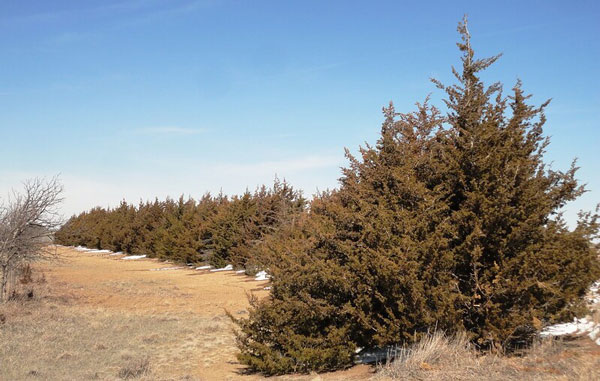A state forest official said an initiative to support windbreaks and other green infrastructure on Kansas farms is much-needed in light of recent data indicating that more than half of windbreaks in the state are in fair to poor condition.
Robert Atchison, recently retired coordinator of the Kansas Forest Service’s rural forestry program, said the Great Plains Initiative 2 is a continuation of an inventory of windbreaks in Kansas, Nebraska and the Dakotas that first began in 2008 and is sponsored by the U.S. Department of Agriculture’s Forest Service.
The most recent inventory of windbreaks in the Great Plains – completed in 2019 – indicates windbreaks throughout the region are deteriorating. The report is available online from the Kansas Forest Service.
In the 1930s, at the height of the Dust Bowl, the federal government invested $13.8 million to establish more than 200 million trees and shrubs in windbreaks throughout the Great Plains (Figure 1). Today, this green infrastructure exceeds 80 years of age and is in a state of age- and climate-related decline.

Figure 1. The most recent data provided through the Great Plains Initiative 2 notes that 55% of Kansas windbreaks are in fair to poor condition. Photo credit: K-State Research and Extension.
There are more than 118,000 windbreaks in Kansas, comprising 261,000 acres and stretching 31,348 miles – enough to cross the state east to west more than 76 times. However, an average windbreak in Kansas only takes up a little more than two acres and is generally around 1,500 feet in length.
The great benefit of windbreaks is the extended protection they provide beyond their footprint, which is a distance and area at least 10 times their height on the leeward side and two times the height on the windward side. In Kansas, that adds up to almost a million acres for which windbreaks provide protection to livestock, cropland and farmsteads.
The 2019 data from the Great Plains Initiative reported that 45% of Kansas’ windbreaks are in good condition, 37% in fair condition and 18% in poor condition. The report also outlined the types of windbreaks located in Kansas:
- 61% are farmstead windbreaks planted around homes and outbuildings.
- 26% are field windbreaks to reduce soil erosion, which aids crop yields.
- 11% are windbreaks to provide protection for livestock.
According to Atchison, since 55% of windbreaks in Kansas are in fair to poor condition, it suggests that there is a real need to encourage our farmers and ranchers to renovate and manage windbreaks before they lose their ability to provide protection. Fortunately, there are USDA conservation programs like the Environmental Quality Incentives Program (EQIP) that can help with the cost of renovating and establishing windbreaks.
The importance of windbreaks is illustrated by the fact that Kansas has 2.5 million acres of cropland where the soils are particularly susceptible to erosion, many of these in southwest and south-central Kansas. An inventory kept by the Natural Resources and Conservation Service indicates that Kansas croplands experience 70.6 million tons of wind erosion annually – or about 2.68 tons per acre each year.
Farmers and ranchers interested in renovating windbreaks should first contact a district forester, who can provide on-site advice for renovating the windbreaks, and connect producers with EQIP assistance to help get the work done.
There are seven forest districts in Kansas. The contact information for each is available on the website for the Kansas Forest Service, or interested persons can call the state office in Manhattan at 785-532-3300.
This eUpdate is a slightly edited version of a recent K-State Research and Extension press release. The full press release can be viewed at: https://www.ksre.k-state.edu/news/stories/2021/12/forestry-windbreaks-deteriorating-in-kansas.html
Robert Atchison, Rural Forestry Coordinator (retired) – Kansas Forest Service
Ryan Armbrust, Rural Forestry Coordinator (current) – Kansas Forest Service
rarmbrust@ksu.edu